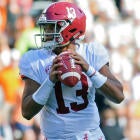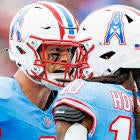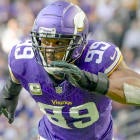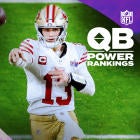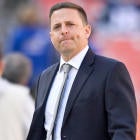With Tua Tagovailoa and Justin Herbert headlining the 2020 quarterback draft class, we're bound to witness another multi-quarterback race for the No. 1 overall pick throughout draft season, just like we were just two years ago before Baker Mayfield sky-rocketed to the top spot.
Knowing what we do about the 2018 class after their rookie seasons in the NFL and everything to date regarding the 2019 rookies and the 2020 class as it gets set to embark on another collegiate season, let's rank the signal-callers from 2018, 2019, and 2020 together.
1. Baker Mayfield, Browns
Mayfield had flashes early on as the Browns starter, then was a blast down the stretch. He eclipsed the 125 QB rating mark in four of his last seven starts, although those outings came against the 24th (Panthers), 25th (Bengals) and 29th (Falcons) ranked teams in Football Outsiders' pass defense DVOA, such a stretch is super impressive for any quarterback, much less a rookie.
I had Mayfield as my QB5 in the famed 2018 class of signal-callers. Essentially, my reasoning for the "low" ranking centered around a thought that he wouldn't ever be in as amazing of a situation as the one he was in at Oklahoma with a brick wall offensive line and a myriad of pass-catchers much more talented than their competition. I saw more Case Keenum than Russell Wilson.
After a few games to acclimate to the speed of the NFL, Mayfield was fearless as a passer, routinely giving his wideouts and tight ends a chance to make a play on the football. He typically threw with pinpoint accuracy, and mostly knew where to go with the football. The coaching change from Hue Jackson to Freddie Kitchens was a godsend for Mayfield, as the latter incorporated considerably more safety-stressing vertical routes, familiar throws for his quarterback after his illustrious tenure in Oklahoma's Air Raid system.
The indecisive, late throws popped up from time to time, as they do with every rookie. Two first-half picks in the season finale in Baltimore were prime examples of that. With Mayfield, it turned out that his vast experience passing the football with the Sooners prepared him outstandingly to throw darts all over the football field in his first NFL season, and he landed on a team with a sturdy offensive line and a burgeoning group of pass-catchers that now includes Odell Beckham Jr. Goodness. Without question, Mayfield is considerably closer to proving me wrong than right, but he'll need to build on a strong rookie season to live up to the unusually massive expectations in Cleveland during his second NFL campaign.
2. Tua Tagovailoa, Alabama
Tagovailoa reminds me a lot of Mayfield in college. Smaller, athletic, pocket-passing quarterback who wants to stretch the field any chance he gets and can get through progressions as well as occasionally throwing with anticipation. The college situations are almost identical too.
They have similar weaknesses. Both can prematurely transform into a running back inside the pocket, lock onto a target for a split-second too long and fail to recognize zone defenders. But the strengths for the two far outweigh the weaknesses.
Tagovailoa completed 69% of his passes at a ridiculous 11.2 yards-per-attempt average with 43 touchdowns and just six interceptions in 2018. Mayfield's second-to-last season at Oklahoma? 70.9% completion, 11.1 yards per attempt, 40 touchdowns, eight picks.
The main difference between the two ... Mayfield has a stronger arm. The ball jumps out of his hand more noticeably than Tagovailoa. But I'm deep into nit-picking territory now. After a somewhat disastrous national title game, the Crimson Tide actually will be out to prove something in 2019 and have a microscopic chip on their shoulder for, essentially, the first time in more than a decade under Nick Saban.
3. Justin Herbert, Oregon
Another comparison for you, as Herbert is eerily similar to Sam Darnold. Here's how. He's capable of making the most jaw-dropping throws you'll ever see to any level of the field, inside or outside the pocket. He's also capable of looking completely out of sorts for an entire game that features brutal decisions and an assortment of turnovers.
In between the transcendent highs and ghastly lows, Herbert provides steady quarterback play from inside the pocket, and he's a plus athlete at 6-foot-6 and 235-ish pounds with a clean delivery and live arm.
The loss in Pullman to Washington State last year was vintage Herbert, as the Ducks got into a 27-0 deficit by halftime. He was really bad in the first half, downfield misses and failure to recognize oncoming pressure led to offensive stagnancy. In the second half, Herbert legitimately looked like Andrew Luck at Stanford in 2011, despite a few more misfires deep. Oregon charged back to make it 27-20 by midway through the fourth quarter. The pocket presence was excellent, the anticipation throws to the intermediate level had plenty of velocity and accuracy. The scrambling was effective and only a last resort.
Herbert had bad outings against San Jose State but shredded a strong Utah defense and ended with a pedestrian showing against Michigan State in a bowl game win. If the brilliant pocket movement he flashed as a junior becomes more customary in 2019 and his downfield touch improves, Herbert has the natural talent in his legs and arm to be the No. 1 overall pick.
4. Sam Darnold, Jets
Much of what I wrote above about Herbert is true of Darnold. Incredibly high highs and stunning, what-the-heck-was-that lows. My QB4 in the 2018 class had a bumpy roller coaster of a rookie season that tapered off into a relatively smooth ride over the final six games for the Jets.
Why was he my QB4, you ask? The propensity to put the ball into precarious spots, his long release and ball security issues worried me. The high-degree-of-difficult throws always intrigued me.
Early on, as a 21-year-old starter, Darnold looked out of place in most situations. He had five games with a completion percentage of 50 or lower in his opening eight contests, yet in two other games, he managed a quarterback rating over 110.
Like at USC, Darnold provided ridiculously accurate tosses on long throws over and between coverage just about every game for the Jets, and those plays became more frequent as the season progressed. The final six games in which he took a big step forward was undoubtedly encouraging and more impressive on film than in the stat book. In those games, Darnold completed 61.5% of his passes at 7.07 yards per attempt and a 82.4 rating with six touchdowns and five picks.
Age is on his side. He won't be 22 until June, which means the Jets' starter in 2019 is only two months older than No. 1 overall pick Kyler Murray, and the former already has a year of NFL experience under his belt.
5. Josh Allen, Bills
Who would've thought an injury mid-season to Allen would've been the best thing for him during his rookie season? From an emergency relief appearance in Week 1 to the time he was injured against the Texans in Week 6, he looked like the cannon-armed, overly antsy, inaccurate quarterback many thought he was as a prospect coming out of Wyoming. Frankly, Allen didn't look NFL-caliber in the first month and a half of his career. My QB6 in the 2018 class only had one game with completion percentage over 60 and threw two touchdowns to five picks. It was ugly.
Allen didn't see the field again until late November and looked like a completely different quarterback, much more like the Cam Newton-esque type Buffalo GM Brandon Beane likely envisions his young signal-caller ultimately becoming.
No, the post-injury numbers weren't amazing by today's standards. But like Darnold, the on-field growth was obvious yet there's significant room for growth. In his last six games as a rookie, Allen completed 51.9% of his passes at 6.86 yards per attempt with eight touchdowns and seven picks. And he finished the season by averaging 11.0 Intended Air Yards, the highest figure among all qualifying quarterbacks, per NFL Next Gen Stats. And back to Newton for a minute, Allen's running prowess was downright freaky after his injury. He ran the football 54 times for 476 yards (8.81 yards per) with four rushing scores.
Allen is highly unlikely to ever be a 65% completion quarterback. His lacking short-area accuracy means he's not a West Coast type. Like Newton, he's a vertical-passing signal-caller, which means the completion percentage will likely stay relatively low but Buffalo hopes the deep strikes -- and running element -- will complement each other very well and generate a plethora of explosive plays in 2019 and beyond.
6. Drew Lock, Broncos
Lock was my QB1 in the 2019 class, ever-so-slightly above Murray. His footwork needs some fine-tuning, more specifically, he needs to eliminate the plays in which he floats backward against pressure. But I love how Lock improved his overall game -- including pocket presence -- in each of his four seasons as Missouri's starter, and as a senior, the accuracy concerns that arose after his initial three collegiate seasons, were eradicated. He took care of the football better -- 3.1% INT rate in 2017 vs. 1.8% in 2018 -- while increasing his completion percentage from 57.8 to 62.9.
While his general stats were down, we mustn't forget that in an Oklahoma-style Air Raid offense in 2017, Lock tossed 44 touchdowns to just 13 picks at a hefty 10.2 yards-per-attempt average.
As a senior, he flashed awesome pocket maneuverability and proved he can read the entire field while quickly sifting through his progressions. Also, Lock doesn't let a bad decision lead to timidness later in the game or even on the next possession.
He won't have to play instantly in Denver with Joe Flacco in the mix, and that's probably a good thing. By focusing on curbing his occasional tendency to sink away from pressure and instead stepping up toward the center during practice, Lock can assume the starting role in Year 2 and hit the ground running.
7. Kyler Murray, Cardinals
Murray was my QB2 in the 2019 class behind Lock, and the main reason was due to the vast experience disparity between the two. Murray attempted 519 passes in college, and 377 in his one year as Oklahoma's starter.
Lock attempted 1,553 passes and threw it 437 times as a senior in 2018. Murray's lack of height doesn't concern me. Neither does his ability to make NFL throws from inside the pocket. In fact, for a signal-caller with as much electric scrambling ability as Murray, I was majorly impressed with his willingness to hang in and make accurate throws to all portions of the field.
Yes, the environment in Oklahoma was luxurious for Murray, but Mayfield's solid rookie campaign leads me to believe that isn't necessarily a detriment to a quarterback's development in the NFL, especially because when evaluating any prospect, distilling what that player did on specific plays is the name of the game.
I am worried about Murray dealing with complex coverages and exotic blitz packages for essentially the first time. Mayfield was a full-time, three-year starter at Oklahoma. Murray played in 14 games for the Sooners in a wide open Big 12 and looked flabbergasted by Alabama's defense in the first half of the College Football Playoff semifinal.
The natural ability as an athlete and, yes, as a passer is undeniably there. His arm is strong -- maybe a shade weaker than Mayfield's. Murray is very accurate to all portions of the field, aggressive down the seam, and is a souped up Tyrod Taylor as a scrambler/designed runner. Basically, he's the perfect fit in Arizona with Kliff Kingsbury and has a fun group of weapons at his disposal. However, the offensive line is not good, which could become a huge problem for Murray as he tries to acclimate to the NFL.
8. Lamar Jackson, Ravens
Like Darnold and Allen as rookies, Jackson played better than the traditional numbers indicated in the final two months of the season. And he didn't start until then. As Baltimore's quarterback from mid-November on, the former Heisman winner completed 58.2% of his passes at 7.05 yards per attempt with a 82.6 rating, five touchdown passes and three picks.
The rushing figures can't be ignored though. Jackson toted the rock a whopping 119 times for 556 yards with four scores on the ground in the last seven games of the regular season for the Ravens. He and the Ravens' bland receiving corps and offensive line were totally overmatched by the Chargers' pass rush and deep secondary in the opening-round playoff loss.
Jackson started his college career as a one-read-then-go running quarterback and progressed in all phases of playing the position as a sophomore and junior which was integral in him being a first-round selection.
Though slight of frame, Jackson has elite vision, twitchiness, and speed for the quarterback spot. As a passer, his accuracy can be an issue at times, and he'll decide to run more quickly than others. But he did show pocket-drifting flashes as a rookie and can drop the ball into the bucket down the field. Also, he's awesome throwing on the run.
Jackson will spearhead a throwback type run-obsessed Ravens club in 2019 that'll look to occasionally strike deep with rookies Marquise Brown and Miles Boykin while working the intermediate level of the field with former third-rounder Mark Andrews. If his collegiate career was any indication of his developmental arc, my QB2 from the 2018 class is in for a breakout season in his second year in the NFL. His offensive coordinator, Greg Roman, got the most out of Colin Kaepernick in San Francisco and Tyrod Taylor in Buffalo, so the coaching suits Jackson wonderfully.
9. Dwayne Haskins, Redskins
Haskins was my QB3 in the 2019 class, distantly behind Lock and Murray. After writing about my questions with Haskins' game for months, I summarized those questions last week. Basically, the Ohio State skill-position players were unreal. Many of Haskins' throws were incredibly easy. He's willing but slow to drift away from pressure in the pocket, and I don't love his accuracy beyond 15 or 20 yards.
I do love that he's a pocket passer first and foremost. That's the time-tested way to win at the position in the NFL long term. But Haskins is nowhere near being a finished product, although his experience as a short-passing point guard with the Buckeyes in 2018 does match well with Jay Gruden's West Coast offense.
As for that experience, I of course feel the same about it with Haskins as I do with Murray. Having a massive amount of collegiate experience is invaluable for quarterbacks, and Haskins has 590 attempts on his collegiate resume. He gets through his reads very fast for a relatively unseasoned passer. His arm strength is good, not great, and the accuracy is solid on those short routes. Anticipation throws? Few and far between. There's a ton of inherent talent with Haskins, and I certainly don't blame him for declaring early into a weaker-than-usual quarterback class. But he needs time to mature at the NFL level.
10. Josh Rosen, Dolphins
What a strange calendar year for Rosen, my QB3 in the 2018 class. He's now in Miami which ... is not exactly much better of a situation than the abomination of an offensive setup he had in Arizona as a rookie. Laremy Tunsil is a good left tackle. The rest of the Dolphins' projected starting offensive line? All big question marks. Chris Reed, Daniel Kilgore, Jesse Davis, and Jordan Mills.
The skill-position group isn't anything to write home about either.
And there's Ryan Fitzpatrick, everyone's favorite September and October quarterback, likely in front of him on the depth chart to start the summer.
My pre-draft comparison for Rosen was Eli Manning, a squeaky clean prospect from the mechanical standpoint who's able to make any throw you ask of him but also too often makes poor decisions into traffic and often gets overly antsy while under pressure. Rosen's arm is respectable, he can make anticipation throws, and there aren't any real accuracy issues. His delivery is as clean as they come.
Do I think Rosen can resurrect his career in Miami? Yes. He does have the pure pocket-passing skills, and coverage-reading ability to do so. But it's far from a guarantee to happen, and he unfortunately may never get the type of supporting cast almost every young quarterback needs early in his pro career to be successful. If Rosen has already been and will continue to be shellshocked by the pass rush -- thinking about that before reading route combinations and coverages -- he'll likely never live up to the hype in the NFL.
11. Daniel Jones, QB, Giants
My apologies, Giants fans. But this probably shouldn't come as a surprise. Jones was my QB7 in the 2019 class and ultimately went No. 6 overall. He looks the part. He's simply not accurate and is mostly disastrous under pressure. Plus, Jones doesn't have the arm to save him in situations in which he throws late.
The athleticism is intriguing, and he showed he can be effective on designed runs. Because of his quick release and the fact that he's much more accurate on short passes than down the field, he fits with what Pat Shurmur wants in his quarterbacks as a West Coast enthusiast.
Who knows when Jones will actually see the field. Three years? This season if Eli flops without Beckham? Jones seems like a short-term starter or decent backup type who could operate a pro offense early in his career yet wouldn't do so efficiently.













